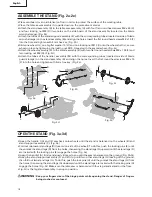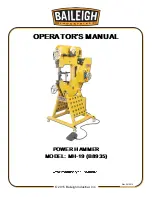
8
English
CAUTION:
Follow safety instructions that appear on the front of your saw.
• NEVER PLACE ARMS OR HANDS IN LINE WITH THE PATH OF THE CUTTING BLADE.
• ALWAYS USE BLADE GUARD, RIVING KNIFE, AND ANTI-KICKBACK PAWLS
on all through
cut operations. Through cut operations are those in which the blade cuts completely through the workpiece
as in ripping or cross cutting. Keep the blade guard down, the anti-kickback pawls down, and the riving
knife in place. Make sure the blade guard, riving knife, and anti-kickback pawls are reinstalled immediately
after finishing any non-through cut operations which require their removal.
• ALWAYS
lock the rip fence and secure bevel adjustment firmly before cutting.
• ALWAYS SECURE WORK
firmly against the rip fence or miter gauge.
• ALWAYS USE A PUSH STICK.
A push stick is a device used to push a workpiece through the blade
instead of using your hands. Size and shape can vary but the push stick must always be narrower than
the workpiece to prevent the push stick from contacting the saw blade. When ripping narrow stock, always
use a push stick, so your hand does not come close to the saw blade. Use a featherboard and push blocks
for non-through cuts.
• NEVER
perform any operation “freehand” which means using only your hands to support or guide the
workpiece. Always use either the rip fence or miter fence to position and guide the work.
• PROVIDE AUXILIARY WORKPIECE SUPPORT TO THE REAR AND/OR SIDES OF THE SAW
TABLE FOR LONG AND/OR WIDE WORKPIECES
TO KEEP THEM LEVEL.
A long and/or wide
workpiece has a tendency to pivot on the table’s edge, causing loss of control, saw blade binding and
kickback.
• NEVER
stand or have any part of your body in line with the path of the saw blade.
• NEVER
reach behind, over, or within three inches of the blade or cutter with either hand for any reason.
• MOVE THE RIP FENCE
out of the way when cross cutting.
• DO NOT USE THE MITER GAUGE AND RIP FENCE
during the same operation.
• NEVER USE THE MITER GAUGE TO FEED THE WORKPIECE WHEN RIPPING AND DO
NOT USE THE RIP FENCE AS A LENGTH
STOP WHEN CROSS CUTTING WITH THE MITER
GAUGE.
Guiding the workpiece with the rip fence and the miter gauge at the same time increases the
likelihood of saw blade binding and kickback.
• NEVER
attempt to free a stalled saw blade without first turning the saw OFF and disconnecting the saw
from the power source.
• PROVIDE ADEQUATE SUPPORT
to the rear and sides of the saw table for wide or long work pieces.
A wide or long workpiece has a tendency to pivot on the table’s edge, causing loss of control, saw blade
binding and kickback.
• AVOID KICKBACKS
(work thrown back toward you) by:
a) Keeping blade sharp.
b) Keeping rip fence parallel to the saw blade.
c) Keeping spreader, anti-kickback pawls, and blade guard in place and operating.
d) Not releasing the work before it is pushed all the way past the saw blade using a push stick.
e) Not ripping work that is twisted or warped or does not have a straight edge to guide along the fence.
• NEVER CUT METALS, CEMENT BOARD, OR MASONRY.
These materials need to be cut by
other special tools.Cutting them with this tool can result in damage to the saw and personal injury.
• IF THE POWER SUPPLY CORD IS DAMAGED,
it must be replaced only by the manufacturer or
by an authorized service center to avoid risk.
• AVOID AWKWARD OPERATIONS AND HAND POSITIONS
where a sudden slip could cause
your hand to move into the cutting tool.
• MAKE SURE THE WORK AREA HAS AMPLE LIGHTING
to see the work and that no obstructions
will interfere with safe operation BEFORE performing any work using the table saw.
• ALWAYS TURN OFF SAW
before disconnecting it, to avoid accidental starting when reconnecting
to power supply.
• SAVE THESE INSTRUCTIONS.
Refer to them frequently and use to instruct other users. If you loan
someone this tool, loan them these instructions also.









































